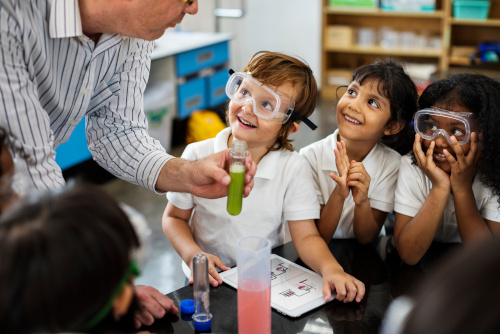How much time do you think the average K–3 student spends learning about science? Thirty minutes a day? An hour a day? Well, according to the 2018 National Survey of Science and Mathematics Education, K–3 students spent an average of 89 minutes studying ELA, 57 minutes learning math, and a miniscule 18 minutes a day on science. These numbers aren’t too surprising when you consider that reading and math are high priorities in early grades. However, when educators fail to make room for science in their lessons, students can still lose out on essential growth.
Science is much more than naming planets or memorizing the periodic elements. At its heart, science is about tapping into a student’s innate curiosity and creativity while fostering their critical thinking skills. It encourages them to ask important questions and discover answers by carefully examining their surroundings.
Given the incredibly packed school day schedule, finding room for science will take more than a little flexibility and creative thinking. Here are just a few resources and strategies that teachers can put into practice right away:
1. Think 15: Teachers can start by engaging students in activities that will leave them feeling accomplished and treat them like real scientists, all in only 15 minutes or less. These can include STEM challenges like a marble run or a card tower challenge. Simply provide students with supplies, criteria, and constraints and then challenge them to meet a specific goal. Additionally, teachers can take things a step further with Inquiry in Action lessons. These free resources are designed to engage students and get them thinking deeply about their topic. Best of all, the lessons take anywhere from 15-30 minutes and with little to no prep for the teacher.
2. Think Culture: Use this instructional model to remind your students that these “soft” skills are just as important as the science, math, ELA, and social studies content they learn. The Claim, Evidence, Reasoning format is a great way to promote critical thinking, self-direction, and perseverance. Students should answer a question clearly in their Claim. Then they should use Evidence (analyzed data) to support their claim. Students should finish by providing Reasoning (an argument) as to why the evidence supports the claim. CERs can be used in any content area where students need to support a claim with sound evidence and reasoning. Check it out in action here!
3. Think Outside: There are great resources for teaching science all around us, we just have to look! An ideal place to start is with a field trip. Some investigations are too messy or complicated for a classroom, so it helps to have a place where students can really let loose. Consider exploring one of VAI’s 40 different field trips that are standards-aligned, engaging topics for K-12 students. Additionally, classrooms can Skype a Scientist to talk about the research that they do or the jobs that they hold. Not only does this help our students learn, but it can also take the pressure off of the teacher to deliver content they may not have an abundance of knowledge about.
4. Think Tech: Technology can help support science investigations in a big way! From providing collaboration tools, to simulated investigations, technology can assist in making room for science. Teachers can use tools such as Padlet for collaboration, Phet for simulations, and Spheros for coding. Additionally, NexGen Inquiry Quests come complete with asynchronous student-facing videos and instructions to conduct science investigations and engineering challenges.
5. Think Cross-Curricular: One way to draw out the most potential in students is by using science as the engager, or phenomenon, to connect the other content you need to teach. Some great cross-curricular examples include The Dirty Truth, a lesson where students learn about the importance of environmental protection and the wonders of space, and What’s in Your Water?, a project-based learning unit where students build watershed models and collect local water samples to run tests to determine water quality. These will save instructional time, but also show students that math, ELA, science, and social studies do not have to live alone in their content silos.
VAI’s Chief Scientific Officer, Dr. Peter Jones, puts it succinctly when he states: “I think it’s very important for young people to learn about science because it teaches them how the world works and, most importantly at the moment, it teaches them the value of critical thinking – distinguishing truth from fiction.”
Science is more than a subject; it’s a necessity for young minds. So, let’s make sure we’re giving students the opportunity to test their curiosity, creativity, and critical thinking skills. Create a little room for science exploration, and you’ll be amazed at what your students can achieve.
Related:
5 math resources to boost student inquiry
How to deal with the STEM situation
- 4 ways to encourage play in education - April 25, 2024
- It’s time to pay student teachers - April 25, 2024
- The evolving requirements of a K-12 school network - April 24, 2024

